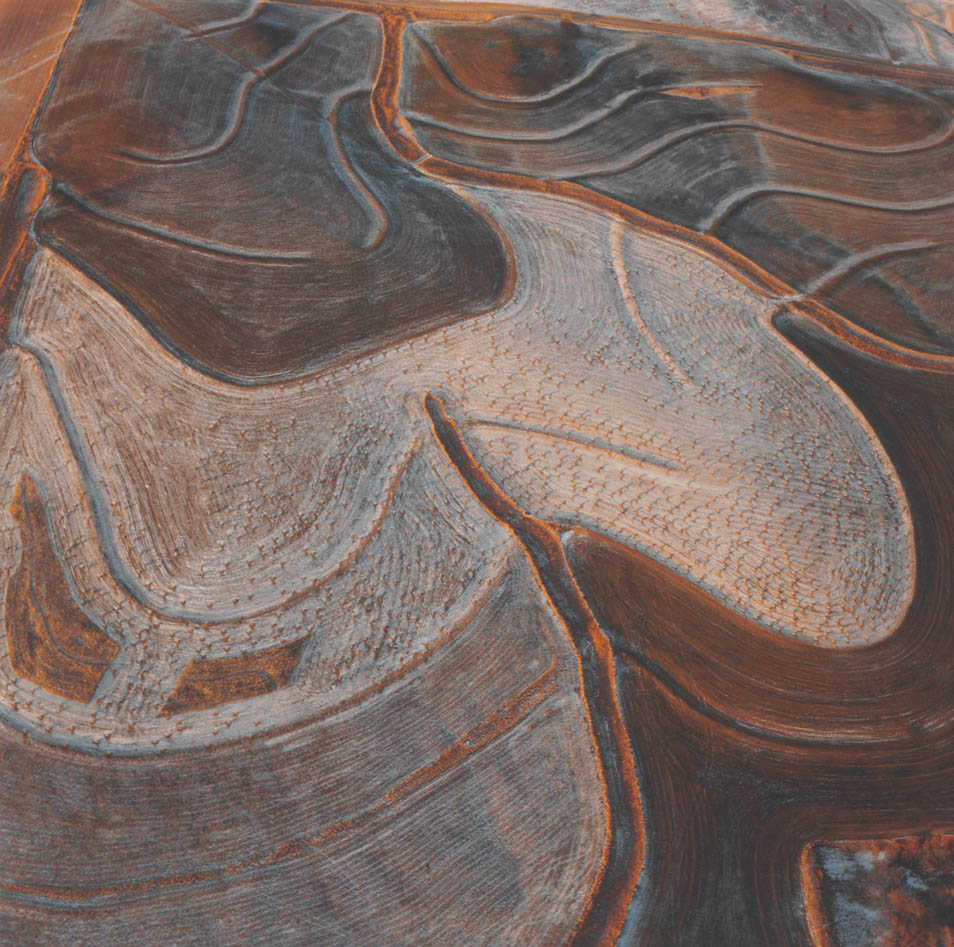
Eye Wonder presents more than one hundred photographs made between 1865 and 2004 that demonstrate how women have long embraced the subjectivity—and even quirkiness—of the camera’s eye. Selecting subjects from skyscrapers to silverware, the artists—including Merry Alpern, Berenice Abbott, Wijnanda Deroo, Candida Höfer, Graciela Iturbide, Dorothea Lange, Dodo Jin Ming, and many others—have created compelling images that reflect their unique viewpoints and invite new interpretations.
Taken from a balcony or atop a ladder in a dance studio, Margaret Bourke-White’s Machine Dance, Moscow Ballet School, 1931, presents six dancers with their arms linked together in imitation of a chain-belt conveyer. With its spare background (the dance studio’s floor) and high-value contrast, Machine Dance appears more like a modernist photomontage than a traditional documentary work. Bourke-White (1904–1971) was a renowned photojournalist and the first Western photographer to enter the Soviet Union to record its industrialization in the late 1920s.
Bourke-White and other modernist photographers pursued techniques (unusual views and angles and experimentation with lighting) that allowed them to highlight the formal elements of shape, value, and texture. Figure studies by Americans Barbara Morgan (1900–1992) and Ruth Bernhard (1905–2006) and floral still lifes by Imogen Cunningham (American, 1883–1976) convey these artists’ commitment to developing simple but evocative compositions. By shooting intense close-ups of natural forms, they drew their images toward abstraction. Seen through their cameras’ eyes, the curly stigmas in the center of a flower, or a leg folded against a belly, appear simultaneously familiar and alien.
A number of contemporary photographers use still life to address the social experience. Stilleven met melk (Still Life with Milk), 2002, by Dutch artist Elspeth Diederix (b. 1971) seems to depict the aftermath of a spilled purse, with a pack of chewing gum, nail clippers, car keys, and other items scattered in a pool of milk. The large-scale print highlights the volume and banality of items that we insist on keeping close during the course of our daily lives. American artist Linda Butler (b. 1947) combines a modernist aesthetic, a documentarian’s sensitivity, and a conceptual focus to produce still lifes during her travels around the world. Her series of images made in rural Japan, for example, feature sunlit radishes, prickly tea whisks, and gleaming wooden tables that she observed while visiting the region for several months. Butler’s richly toned prints convey the burnished beauty of the objects and the wonder she experienced in viewing them.

Landscape photography today often critiques ecological issues or, in true postmodern fashion, older landscape art. Terry Evans (American, b. 1944) utilizes aerial perspective to create her images of the Midwest. The linear patterns of lapping waves, plowed fields, and city streets that dominate her works reference the underlying rhythm of the earth as well as humankind’s endeavors to manage it.
Portraiture, because it involves empathy and patience, was long considered the most suitable type of photography for women to practice. In the early twentieth century some women created portraits to provide income that enabled them to pursue more inventive (and less lucrative) subjects. Gisèle Freund (French, born Germany, 1912–2000) is well known for her photojournalistic work, but she also created a series of color portraits of writers and artists in Paris—Colette, Henri Matisse, and Virginia Woolf, among others—between the world wars. The muted tones of these images do not look particularly realistic to contemporary eyes, but Freund’s unsparingly tight framing of her subjects’ faces amplifies their famously strong personalities.
We are culturally conditioned to expect that portraits will offer insight into a sitter’s personality. Rineke Dijkstra (Dutch, b. 1959) and Hellen van Meene (Dutch, b. 1972) confound those expectations. Posing her models frontally and with flat expressions, Dijsktra produces images that are breathtaking in scale and detail and equally arresting in their emotional neutrality. Much like a film director, van Meene asks her models to act out a particular emotion or idea, but we must speculate about the narrative being expressed in each of her untitled portraits.
Contemporary artists often use photography as part of their art-making process. Sandy Skoglund (American, b. 1946) designs, sculpts, paints, installs, and lights the surreal tableaux that she photographs. By making an image of an installation that is wholly her own creation, Skoglund emphasizes the essential synthetic nature of art. An art object—whether it is the fish that Skoglund sculpted for Revenge of the Goldfish, 1981, or her photograph of them—is only an allusion to reality.
The rich tapestry of works in Eye Wonder exemplifies the depth of Bank of America’s outstanding collection of art by women. Whether a romantic portrait shot in the 1920s or an edgy conceptual piece created yesterday, the pictures illuminate the wondrous and enduring complexity of the photographic image.
Eye Wonder: Photography from the Bank of America Collection is provided by Bank of America Art in our Communities (TM) program and the Members of NMWA. Lead support for education programs associated with this exhibition is provided by Bank of America.
